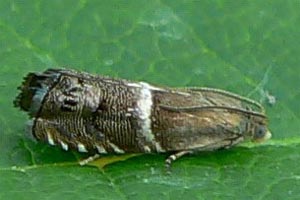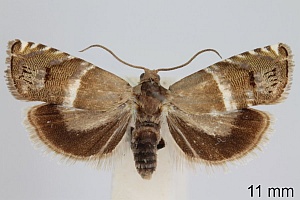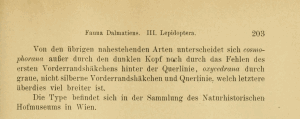

 +7Kontinente:EUAS
+7Kontinente:EUAS1. Lebendfotos
1.1. Falter
2. Diagnose
2.1. Geschlecht nicht bestimmt
2.2. Erstbeschreibung
3. Biologie
3.1. Nahrung der Raupe
- [Cupressaceae:] Juniperus excelsa (Griechischer Wacholder)
- [Cupressaceae:] Juniperus foetidissima (Stinkender Wacholder)
P. mariana gehört zu den als Raupe in Juniperus-Beeren lebenden Arten. Zlatkov (2008: 323) berichtet aus der Kresna-Schlucht: "Material examined. 1 ♀, Kresna Gorge, 31.V II.2007 at light B. Zlatkov & O. Sivilov leg.; 1 ♀, the same locality, 23.IX .2007, flying in the evening around J. excelsa trees, B. Zlatkov leg. Remarks. Them oth is said to fly in V-VI (Razowski, 2003) but I found the first specimen two months later, so obviously the second specimen belongs to a partial second generation. Although this species is a serious pest in m any places, I could see only a few damaged cones. Probably not so rare in Bulgaria, but it could be found in very limited areas in our country because of the local distribution of the food plant (J. excelsa). The species is known from Croatia, Turkey, Caucasus (Razowski, 2003) and Crimea (Budashkin, 2004).".
Moraiti et al. (2019) untersuchten auf Zypern tierische Bewohner der "Berries" von Juniperus foetidissima. Drei Arten von Microlepidoptera wurden per Barcode-Bestimmung zugeordnet: "Nine individual microlepidopteran larvae were isolated from infested berries collected by cutting and were used for molecular characterization and typing. [...] Larvae of a size allowing identification of Pammene spp. were collected from mid-July onwards, while for A. aurulentella from mid-August. Usually, berries were infested with just one larva, but in some cases, we retrieved 2 or 3 larvae of A. aurulentella per berry. [...] DNA barcoding Sequencing data were deposited in the NCBI GenBank database with Accession Numbers of KY989993-KY989995 and MF001914-MF001919. DNA BOLD (http://www.boldsystems.org/) identification results for four samples revealed 99.5–99.8% similarity with Pammene mariana (Zerny) (Lepidoptera: Tortricidae) from Bulgaria (BOLD sample IDs: BTLBP369–11 and BTLBP370–11). Two samples (CYPAM19-MF001918 and CYPAM14- MF001919) showed 98.3% similarity proximity with Pammene juniperana (Millière) (Lepidoptera: Torticidae) (BOLD sample ID: FGMLH474–16) from Germany. Finally, the mtCOI sequence of three other Lepidoptera samples (LEP1CY- KY989993, LEP2CY- KY989994 and LEP3 CY- KY989995) showed 99% homology with Argyresthia aurulentella reported in Bulgaria, Italy, Finland and UK (Bold sample IDs GMBUE3154–14, GMFIG616–12, LASTS819–15, CGUKD606–09, respectively)."
(Autor: Erwin Rennwald)
4. Weitere Informationen
4.1. Andere Kombinationen
- Grapholitha mariana Zerny, 1920 [Originalkombination]
4.2. Synonyme
- Pammene pontica Obraztsov, 1960 [Nr. 05202 in Karsholt & Razowski (1996). Synonym laut [Fauna Europaea] ohne Quellenangabe.
4.3. Literatur
- Moraiti, C.A., Kadis, C., Papayiannis, L.C. & M.C. Stavrinides (2019): Insects and mites feeding on berries of Juniperus foetidissima Willd. on the Mediterranean island of Cyprus. — Phytoparasitica, 47 (1): 1-7. https://doi.org/10.1007/s12600-019-00718-1. [zum PDF-Download der online-first-Version auf researchgate.net]
- Erstbeschreibung: Zerny, H. (1920): Fauna Dalmatiens. III. Lepidoptera. — Zoologische Jahrbücher. Abteilung für Systematik, Geographie und Biologie der Tiere 42: 195-204. Jena (Gustav Fleischer).
- Zlatkov, B. (2008): Several new Leafrollers for Bulgaria and the Balkan Peninsula (Lepidoptera, Tortricidae). — Atalanta, 39 (1/4): 321-326. [PDF auf zobodat.at]













